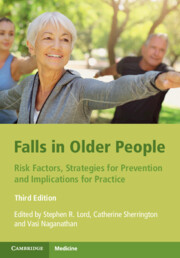Book contents
- Falls in Older People
- Falls in Older People
- Copyright page
- Contents
- Preface
- Contributors
- Part I Epidemiology and Risk Factors for Falls
- Part II Strategies for Prevention
- 16 Exercise to Prevent Falls
- 17 Volitional and Reactive Step Training
- 18 Cognitive-Motor Interventions and Their Effects on Fall Risk in Older People
- 19 Cognitive Behavioural Interventions for Addressing Fear of Falling and Fall Risk
- 20 The Medical Management of Older People at Risk of Falls
- 21 Fall Prevention Interventions for People with Visual Impairment
- 22 Footwear, Orthoses, Walking Aids, Wearable Technology, and Restraint Devices for Fall Prevention
- 23 Environmental Interventions to Prevent Falls at Home and in the Community
- 24 Fall Injury Prevention: Hip Protectors and Compliant Flooring
- 25 Multi-Factorial Fall Prevention Strategies: Where to Next?
- 26 Fall Prevention in Hospitals
- 27 Fall Prevention in Residential Aged Care Facilities
- Part III Implications for Practice
- Index
- References
17 - Volitional and Reactive Step Training
from Part II - Strategies for Prevention
Published online by Cambridge University Press: 04 November 2021
- Falls in Older People
- Falls in Older People
- Copyright page
- Contents
- Preface
- Contributors
- Part I Epidemiology and Risk Factors for Falls
- Part II Strategies for Prevention
- 16 Exercise to Prevent Falls
- 17 Volitional and Reactive Step Training
- 18 Cognitive-Motor Interventions and Their Effects on Fall Risk in Older People
- 19 Cognitive Behavioural Interventions for Addressing Fear of Falling and Fall Risk
- 20 The Medical Management of Older People at Risk of Falls
- 21 Fall Prevention Interventions for People with Visual Impairment
- 22 Footwear, Orthoses, Walking Aids, Wearable Technology, and Restraint Devices for Fall Prevention
- 23 Environmental Interventions to Prevent Falls at Home and in the Community
- 24 Fall Injury Prevention: Hip Protectors and Compliant Flooring
- 25 Multi-Factorial Fall Prevention Strategies: Where to Next?
- 26 Fall Prevention in Hospitals
- 27 Fall Prevention in Residential Aged Care Facilities
- Part III Implications for Practice
- Index
- References
Summary
Step training can be defined as training of single or multiple volitional or reactive steps in an upright (standing or walking) position in response to an environmental challenge. For example, stepping onto a target, avoiding an obstacle, or responding to a postural perturbation large enough to require reconfiguration of the base of support [1]. Volitional step training uses stepping targets or distractors (no-go zones), whereas reactive step training exposes participants to repeated mechanical perturbations that displace body segments and induce unplanned stepping responses. Reactive step training is also referred to as ‘perturbation training’ [2], ‘reactive balance training’ [3], or ‘perturbation-based balance training’ [4].
- Type
- Chapter
- Information
- Falls in Older PeopleRisk Factors, Strategies for Prevention and Implications for Practice, pp. 271 - 286Publisher: Cambridge University PressPrint publication year: 2021
References
- 1
- Cited by



